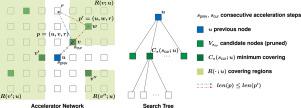Future Generation Computer Systems ( IF 6.2 ) Pub Date : 2020-08-15 , DOI: 10.1016/j.future.2020.07.044 Jiayu Liu , Huaxi Gu , Wenting Wei , Ziqi Chen , Yawen Chen

|
Reconfigurable units such as Field Programmable Gate Arrays (FPGAs) have been used widely as high-performance hardware accelerators for a variety of applications and offer a promising solution to the power bottleneck of current multi-core processors. One emerging trend in hardware acceleration is to build a specialized network for accelerators to support inter-accelerator communications with the goal of increasing acceleration throughput by sharing functions and avoiding frequent reconfiguration. On accelerator networks, data packets are routed in a content-based instead of an address-based manner in that the destinations are determined by the acceleration task—any nodes that support the current acceleration step could be a receiver. Designing an effective and efficient routing algorithm that supports content-based routing becomes an important problem. Adopting shortest path routing for each acceleration task is a standard approach. While Breadth-First Search (BFS) algorithm can be applied, a naive implementation is computationally unaffordable. We propose a new routing algorithm called the Shortest Cycle Routing Algorithm and address the computation inefficiency of standard BFS. We design a branch-and-bound method to effectively prune the search tree without compromising path optimality. The time and space complexities for searching the shortest cycles of an acceleration task of steps improve from to where is the number of accelerators in the network. We analyze locality and path diversity properties of shortest cycle routing and show how they can be used to develop adaptive routing strategy, restrict global flooding to local neighborhood and reduce the number of path cycles.
中文翻译:

二维Mesh加速器网络中基于内容的路由的高效最短路径算法
可重配置单元(例如现场可编程门阵列(FPGA))已广泛用作各种应用的高性能硬件加速器,并为解决当前多核处理器的电源瓶颈提供了有希望的解决方案。硬件加速的一种新兴趋势是为加速器构建专门的网络,以支持加速器之间的通信,其目标是通过共享功能和避免频繁的重新配置来提高加速吞吐量。在加速器网络上,数据包以基于内容的方式而不是基于地址的方式进行路由,因为目的地是由加速任务确定的—支持当前加速步骤的任何节点都可以是接收器。设计一种有效且高效的路由算法以支持基于内容的路由成为一个重要的问题。为每个加速任务采用最短路径路由是一种标准方法。尽管可以应用广度优先搜索(BFS)算法,但朴素的实现在计算上是无法承受的。我们提出了一种称为最短周期路由算法的新路由算法,并解决了标准BFS的计算效率低下的问题。我们设计了一种分支定界方法,可以在不影响路径最优性的情况下有效修剪搜索树。搜索加速任务最短周期的时间和空间复杂性 天真的实现在计算上是无法承受的。我们提出了一种称为最短周期路由算法的新路由算法,并解决了标准BFS的计算效率低下的问题。我们设计了一种分支定界方法,可以在不影响路径最优性的情况下有效修剪搜索树。搜索加速任务最短周期的时间和空间复杂性 天真的实现在计算上是无法承受的。我们提出了一种称为最短周期路由算法的新路由算法,并解决了标准BFS的计算效率低下的问题。我们设计了一种分支定界方法,可以在不影响路径最优性的情况下有效修剪搜索树。搜索加速任务最短周期的时间和空间复杂性 步骤从 至 哪里 是网络中加速器的数量。我们分析了最短周期路由的局部性和路径多样性属性,并展示了如何将其用于开发自适应路由策略,将全局泛洪限制在局部邻域中并减少路径循环的数量。











































 京公网安备 11010802027423号
京公网安备 11010802027423号